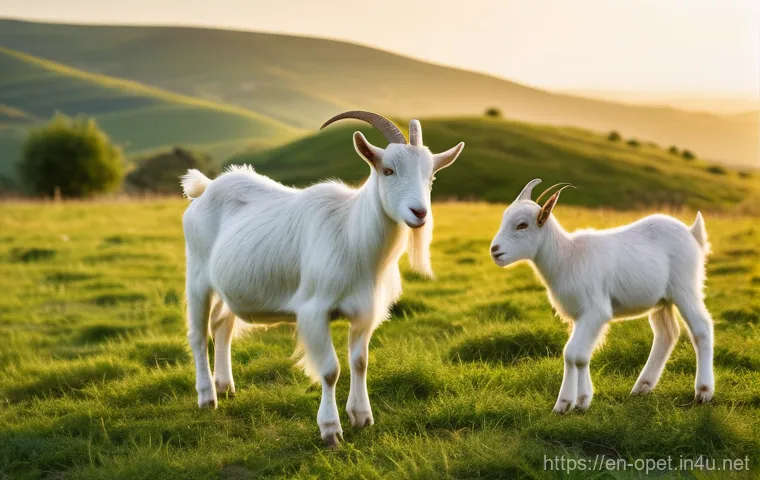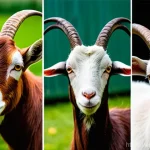You know, there’s just something utterly captivating about watching a group of animals interact, isn’t there? Especially goats! If you’ve ever spent a quiet afternoon observing these charming creatures, you’ll quickly realize there’s so much more to their day-to-day than just munching on grass.
I’ve been fortunate enough to spend countless hours right alongside my own herd, and believe me, it’s like having a live-action soap opera playing out in your backyard!
Each goat has a distinct personality, and together, they form a complex society with its own rules, friendships, and even little dramas. It’s not just random bleating and head-butting; there’s a sophisticated communication system and a clear social hierarchy at play that you’d never expect.
Understanding these intricate dynamics offers such a fascinating window into animal intelligence and social bonds, and it’s genuinely eye-opening to see their world unfold.
I’m always discovering new things that just blow my mind. Ready to uncover the secrets of goat herd behavior with me? Let’s dive deeper and find out exactly what makes these clever creatures tick!
Deciphering the Daily Drama: Goat Communication Secrets

You know, there’s just something truly magical about listening to a herd of goats, isn’t there? It’s not just random noise; it’s a whole symphony of bleats, snorts, and even little grunts that tell a complete story if you know how to listen. I’ve spent countless hours out in the pasture, coffee in hand, just absorbing their conversations. What I’ve learned is that every sound has a purpose, from the softest “maa” to the most urgent, piercing bleat. It’s like they have their own secret language, and the more time you spend with them, the more fluent you become. They use these sounds to call their kids, warn of danger, express hunger, or even just to say hello to their favorite human (which, I like to think, is me!). It’s genuinely heartwarming to hear a mother goat gently humming to her babies, a sound so unique and comforting. It makes you realize how deeply connected they are, and how much they rely on these vocal cues to maintain order and express their needs within the group. Honestly, it’s one of the most rewarding parts of having them around.
The Vocal Vocabulary of Goats
From my experience, the sheer variety of sounds goats make is astounding! It’s not just a generic “baaa.” There are distinct differences. For instance, a short, sharp bleat often means immediate attention is required – maybe a treat is in the offing, or they’re just feeling particularly sassy. A long, drawn-out bleat, especially from a kid, usually signals distress or that they’re searching for their mom. And then there are those subtle snorts and grunts; these are often social, signaling contentment while browsing or a mild disagreement during feeding time. I’ve even heard what sounds like a little cough or huff when they’re mildly annoyed. It truly feels like they’re having full-blown conversations, sometimes even arguing about who gets the best spot in the sun. Learning to distinguish these different sounds has been incredibly helpful in understanding their moods and needs, and honestly, it just deepens the bond I have with them.
Understanding the Silent Signals
Beyond the vocalizations, goats are masters of non-verbal communication. Their body language speaks volumes! A goat with its head lowered and ears back might be signaling dominance or a challenge, whereas a tail held high and wagging could indicate excitement or curiosity. I’ve seen my goats use subtle head tilts and eye movements to communicate with each other, especially when establishing pecking order or deciding where to graze next. It’s like a silent ballet unfolding in the pasture. For instance, if you see a goat stomping its foot, it’s often a warning sign – they might have spotted something unsettling, like a stray dog in the distance. And a playful head butt, especially among younger goats, is all about establishing their place in the social hierarchy without actually causing harm. Paying attention to these subtle cues has taught me so much about their internal world and how they navigate their relationships. It’s truly fascinating to watch their silent exchanges.
| Goat Communication Signal | What It Means (From My Observations) |
|---|---|
| Loud, high-pitched bleat | Distress, alarm, or calling for attention (often from kids). |
| Soft, low bleat/hum | Contentment, mother-kid bonding, or gentle communication. |
| Snorting/huffing | Mild annoyance, warning, or acknowledging presence. |
| Head lowered, ears back | Dominance display, challenging another goat. |
| Foot stomping | Warning of potential danger, unease. |
| Tail wagging (high) | Excitement, curiosity, or anticipation (especially for treats!). |
Navigating the Social Ladder: Hierarchy in the Herd
Every goat herd, big or small, operates on a very clear and often surprisingly complex social hierarchy. It’s not just a free-for-all out there; there’s a definite pecking order, and every goat knows its place. Observing this dynamic has been one of the most intriguing aspects of my time with my herd. You’ll quickly notice who the “boss” goat is – the one who gets first dibs on the best hay, the prime scratching posts, or the juiciest leaves. This isn’t usually established through constant fighting, but rather through a series of subtle dominance displays and occasional, brief challenges. Once established, this hierarchy tends to bring a surprising amount of peace to the herd, as everyone understands the rules of engagement. It’s like watching a miniature society with its own unwritten laws and customs. There’s a certain respect, or perhaps just an understanding of power dynamics, that keeps things running smoothly day after day.
Establishing Dominance: It’s Not Always a Fight
When people think of animal hierarchies, they often picture intense, drawn-out battles. But with goats, while there can be some head-butting, especially when new goats are introduced or young bucks are testing their limits, it’s often much more subtle. The alpha goat usually establishes its position through assertive body language: a confident stance, direct eye contact, and perhaps a gentle nudge that says, “I’m in charge here.” I’ve seen my lead doe, Bessie, simply walk up to a younger, more ambitious goat and give a stare that immediately communicates “back off.” It’s fascinating how quickly the others learn to defer. Sometimes, it’s about who gets to eat first, or who claims the highest spot on the climbing structure. These little interactions solidify their positions, and once everyone’s role is clear, there’s a remarkable lack of conflict. It’s all about maintaining that delicate balance within the group, and each goat plays its part.
Friendships and Alliances Within the Herd
Beyond the strict hierarchy, goats also form genuine friendships and alliances. Just like people, they have their preferred companions! I’ve noticed certain pairs or small groups that consistently graze together, sleep huddled up, and even groom each other. These bonds are incredibly strong, and you can see the distress if a close friend is separated from the group. It’s not uncommon to see two goats, often of similar age or personality, develop a particularly strong connection, always sticking together through thick and thin. These alliances can even influence the hierarchy, with a strong pair sometimes able to exert more influence than a single dominant goat. It adds another layer of complexity to their social structure, showing that it’s not just about who’s strongest, but also about who has the best social network. It’s truly heartwarming to witness these friendships blossom and endure, proving that goats are much more emotionally intelligent than many people give them credit for.
Beyond the Bleat: Understanding Goat Personalities
If you spend any significant amount of time with goats, you’ll quickly realize they are anything but a monolithic group. Each and every one has a distinct, vibrant personality that shines through in their daily interactions. I mean, it’s truly remarkable! I’ve had goats that are total clowns, always getting into mischief and making me laugh, and others that are shy and reserved, preferring to observe from a distance. Then there are the brave explorers, always pushing the boundaries of the pasture, and the gentle nurturers who seem to take all the younger kids under their wing. This individuality is what makes keeping goats so much fun and so endlessly fascinating. It’s like having a whole cast of characters in your backyard, each contributing their unique flair to the herd’s overall dynamic. Trying to lump them all into one category would be a disservice to their complex and engaging natures.
The Shy Observers vs. The Bold Adventurers
In every herd I’ve had, there’s always a clear split between the cautious types and the daredevils. My goat, Luna, for example, is the ultimate explorer. If there’s a new shrub to investigate or a gate left ajar, she’s the first one to check it out, no questions asked. She’s got that bold, inquisitive spirit that makes her a natural leader when it comes to discovering new things. On the flip side, I have a wether named Gus who is the epitome of caution. He’ll hang back, watch Luna’s antics, and only venture forward once he’s absolutely sure the coast is clear and no perceived danger lurks. It’s not just about fear; it’s just how they’re wired. Some goats are born with that adventurous spark, while others prefer the safety of the known. Observing these differing approaches within the same herd really highlights the spectrum of personalities at play and how they contribute to the group’s overall survival strategy, too.
The Nurturers, The Bullies, and The Peacemakers
Just like in any human community, my goat herd has its share of different social roles. There are the natural nurturers, often older does, who seem to have an innate instinct to look after the younger or weaker members. They’ll gently groom them, stand guard, and even share their feed if a little one is struggling. Then, unfortunately, there can sometimes be a bit of a “bully” – a goat who might use their dominance to push others around at the feeder or claim the best resting spots. It’s rarely malicious, more about asserting their position, but it requires careful observation to ensure it doesn’t get out of hand. And of course, there are the peacemakers, those calm, steady individuals who seem to de-escalate tensions just by their presence. They’re often the ones that the others gravitate towards when there’s a minor skirmish brewing. It’s truly amazing to see these roles emerge and how they contribute to the overall harmony, or sometimes slight disharmony, of the group. Each personality is a vital thread in the rich tapestry of the herd.
The Language of Movement: Body Cues You Can’t Miss
Goats are incredibly expressive creatures, and a huge part of their communication comes through their body language. It’s like a silent film playing out in front of you, full of dramatic gestures and subtle movements that convey so much meaning. If you spend enough time observing them, you’ll start to pick up on these cues almost instinctively. For instance, the way a goat holds its head, the position of its ears, and even the flick of its tail can tell you a lot about its mood, intentions, and even what it’s thinking. I’ve found that becoming attuned to these physical signals is just as important as understanding their bleats. It provides an unfiltered window into their minds and helps me anticipate their needs or reactions. It’s a beautiful, understated form of communication that truly deepens your connection with them.
Ears, Tails, and Head Positions: Reading the Signs
Let’s talk about those expressive ears! Perked forward and slightly twitching usually means they’re curious and alert, taking in their surroundings. Flattened ears, pressed back against their head, are a clear sign of annoyance, fear, or even aggression – a signal to give them some space. And their tails? A relaxed, gently wagging tail often means contentment. But a stiff, rapidly wagging tail held high can indicate excitement or, sometimes, a warning that they’re about to kick! Head positions are equally telling. A head held high with a confident stride indicates a dominant or assertive goat, while a lowered head, especially when approaching another goat, can be a sign of submission or an invitation to a playful head-butting match. It’s like they have a whole lexicon of movements, and once you start recognizing them, their world becomes so much more transparent and engaging.
Playful Bounding and Anxious Pacing
Beyond the subtle cues, goats also exhibit broader physical behaviors that speak volumes. Have you ever seen a goat “pronk”? It’s that joyful, high-energy jump where all four feet leave the ground simultaneously. It’s usually a sign of pure exuberance and happiness, especially in young kids playing in a fresh pasture. It just makes your heart melt! On the other hand, anxious pacing or restless movements can indicate stress or discomfort. A goat might pace along the fence line if it’s separated from its herdmates, or if it feels threatened. Sometimes, they might even lie down with their heads in an unusual position, which can be a subtle sign of not feeling well. Observing these larger movement patterns helps me gauge the overall well-being and emotional state of my herd. It’s a constant learning process, but every insight gained helps me to be a better caretaker for these wonderful animals.
Protecting the Pack: Instincts of a United Herd

One of the most profound things I’ve learned from observing my goats is their incredible instinct for self-preservation and, perhaps even more remarkably, their collective desire to protect each other. A goat herd is far more than just a collection of individuals; it’s a cohesive unit, especially when it comes to safety. You’ll see this instinct kick in immediately if there’s any perceived threat, from a barking dog to a sudden strange noise. They don’t scatter randomly; instead, they often huddle together, forming a tighter group, or move as one towards a safer, more defensible position. It’s a testament to their deep social bonds and their understanding that there’s strength in numbers. This collective vigilance and protective behavior are truly fascinating to witness, and it’s a vital part of what makes them such resilient and successful animals in the wild and on the farm.
United Against Threats: The Alarm System
It’s amazing how quickly a goat herd can go from calmly grazing to being on high alert. They have an almost instantaneous alarm system. One goat, often a more vigilant or dominant one, will spot something amiss – perhaps a shadow overhead from a hawk, or a strange scent on the wind. Immediately, they’ll let out a sharp, urgent bleat, and every single head in the pasture will snap up. The entire herd will freeze, scan the environment, and then often gather together. I’ve watched them form a tight circle, facing outwards, when they’ve felt threatened, especially with kids in the group. It’s an instinctive defense mechanism, and it’s incredibly effective. They trust each other implicitly to sound the alarm, and to react as a unified front. This collective response dramatically increases their chances of survival against predators, showcasing a level of cooperation that is genuinely impressive. It always reminds me that even though they’re on my farm, those ancient instincts are still very much alive.
Comfort and Security in Numbers
Beyond active defense, simply being together offers goats immense comfort and security. You’ll rarely see a goat happily isolated for long; they thrive on the presence of their herdmates. At night, they’ll often huddle together for warmth and safety, a cozy pile of goat bodies. During the day, they graze in close proximity, constantly aware of each other’s whereabouts. This isn’t just about avoiding predators; it’s also about psychological well-being. A lone goat can become very stressed and anxious, whereas a goat within a well-functioning herd tends to be calmer and more content. They draw comfort from the collective vigilance and the constant, reassuring presence of their peers. It’s a beautiful demonstration of how social animals derive profound security from their group, reinforcing those vital bonds that make a herd so much more than just a collection of individuals.
Raising a Happy Herd: Practical Tips from My Pasture
After years of living alongside my goat herd, I’ve gathered a fair share of insights into what truly makes them tick, and more importantly, how to foster a happy, healthy, and harmonious environment for them. It’s not just about providing food and water; it’s about understanding their nuanced social needs, respecting their individual personalities, and creating a space where their natural behaviors can flourish. If you’re considering bringing goats into your life, or if you’re looking to enhance the well-being of your existing herd, these tips come straight from my own experiences and what I’ve learned through countless hours of observation. Trust me, a little understanding goes a long, long way in the world of goat keeping, and the rewards of a contented herd are immeasurable.
Creating Spaces for Play and Exploration
Goats are incredibly curious and active animals, and one of the best ways to ensure their happiness is to provide plenty of opportunities for play and exploration. Simply having a flat pasture isn’t enough; they thrive on variety and things to climb on. I’ve found that old tires, wooden spools, sturdy picnic tables, or even just some large rocks can become incredible playgrounds. My goats absolutely adore climbing and balancing, and it provides both physical exercise and mental stimulation. Think about it from their perspective: a constantly changing environment keeps them engaged and prevents boredom, which can sometimes lead to mischievous behaviors. I often move things around in their enclosure to keep it fresh and interesting. This encourages their natural inquisitiveness and keeps them physically fit, leading to a much more contented and well-adjusted herd. Plus, watching them play is just pure joy!
Respecting Individual Personalities and Needs
While goats are herd animals, it’s crucial to remember that each one is an individual with unique needs and preferences. Just like people, some are more dominant, some are shy, and some need a little extra attention. I’ve learned to observe each goat carefully and tailor my interactions accordingly. For example, my shyest doe, Daisy, needs a slower, gentler approach, whereas my boldest buck, Captain, enjoys a good scratch and a bit of a challenge. Understanding these individual nuances helps you build stronger relationships with each animal and ensures that even the most reserved members of the herd feel comfortable and secure. This personalized approach not only makes them happier but also helps you spot any health issues or behavioral changes much sooner, leading to a healthier and more resilient herd overall. It’s all about building that trusting relationship, one goat at a time.
Wrapping Things Up
Well, friends, as we come to the end of our chat about our bleating buddies, I hope you’ve gained a deeper appreciation for the rich and intricate world of goat communication and behavior. Spending time with these amazing creatures has truly opened my eyes to how much they have to tell us, if only we take the time to listen and observe. It’s not just about the cute bleats or the playful headbutts; it’s about understanding a complex social fabric woven with sounds, gestures, and deeply ingrained instincts. Every day out in the pasture offers a new lesson, a new glimpse into their intelligent and often hilarious lives. This journey of understanding has enriched my life immensely, creating a bond with my herd that goes far beyond simple ownership. Honestly, it’s one of the most rewarding experiences a farm enthusiast can have!
Handy Insights for Goat Enthusiasts
Having spent countless hours observing my own herd, I’ve picked up a few nuggets of wisdom that I believe can make a real difference in how you interact with and understand your goats. These aren’t just textbook facts; they’re genuine insights from the dusty, sun-drenched realities of a goat pasture.
1. Patience is Your Best Tool: Rushing things with goats rarely works out. Take your time to simply sit and watch them interact, listen to their various vocalizations, and observe their body language. The more patiently you observe, the more quickly you’ll start deciphering their unique language and understanding individual personalities. It’s truly a skill you build over time, and it’s incredibly rewarding.
2. Enrichment Isn’t a Luxury, It’s a Necessity: Goats are naturally curious and active animals. Providing them with things to climb on, explore, and even just simple toys can drastically improve their mental well-being and prevent boredom-induced mischief. Think old spools, sturdy branches, or even a picnic table they can scale. A happy goat is often a busy goat, and keeping their minds engaged is just as important as keeping their bellies full.
3. Understand the Herd Hierarchy: Every goat herd has a pecking order, and recognizing who’s dominant and who’s more submissive can prevent a lot of stress for both you and your animals. Don’t try to override it; rather, work with it. Knowing who gets first dibs at the feeder, for example, can help you manage feeding times more smoothly and ensure everyone gets their share without unnecessary squabbles. It’s all about respecting their natural social structure.
4. Learn Their Vocal Cues by Heart: While a bleat might just sound like a bleat to the untrained ear, take it from me, there’s a world of difference between a contented hum, an urgent call for their kid, or a warning cry. Spend time associating specific sounds with specific situations. You’ll soon find yourself understanding when they’re simply saying hello, expressing hunger, or alerting you to something unusual. It’s like learning a new language, one bleat at a time!
5. Build Trust Through Consistent Interaction: Goats are smart animals, and they remember kindness (and the occasional treat!). Regular, gentle interactions – offering a scratch behind the ears, a quiet chat, or a hand-fed snack – will build a strong bond of trust between you and your herd. This trust is invaluable, making everything from daily chores to vet checks much less stressful for everyone involved. It’s the foundation of a truly happy relationship with your goats.
Key Takeaways from the Pasture
Bringing all these observations and experiences together, what truly stands out about our caprine friends is their incredible complexity and charm. They’re far more than just lawnmowers with personalities; they’re sentient beings with a rich inner life and a fascinating way of navigating their world.
Goat Communication is a Symphony
Remember, goats communicate through a beautiful blend of vocalizations – from their diverse bleats and snorts to their more subtle hums. But don’t stop there! Their body language is equally expressive, with ear positions, tail wags, and confident postures telling vivid stories. Becoming a keen observer of both their sounds and movements will unlock a deeper understanding of their moods and needs.
Social Bonds Run Deep
A goat herd isn’t just a random collection of individuals; it’s a society with a clear hierarchy, strong friendships, and an innate instinct for collective protection. Understanding these social dynamics helps you appreciate their interactions and ensures you can foster a harmonious environment where every goat feels secure and valued within the group. These bonds are vital for their well-being.
Every Goat is a Unique Character
Just like people, each goat has its own distinct personality. You’ll find the brave adventurers, the shy observers, the natural nurturers, and even the occasional mischief-maker! Respecting and appreciating these individual traits is key to building strong relationships and catering to their specific needs, making your experience with them even more rewarding and personalized. It’s what makes them so endlessly fascinating!
Frequently Asked Questions (FAQ) 📖
Q: How do goats communicate with each other beyond just bleating?
A: You know, from spending so much time observing my own herd, I can tell you it’s much more than just a bleat here and there! Goats have an incredibly nuanced way of talking to each other.
Of course, there’s the obvious vocalization – those adorable bleats can mean anything from “Where are you?” to “I’m hungry!” or even “Hey, get away from my hay!” But honestly, so much of their conversation happens through body language.
I’ve seen it firsthand; a flick of an ear, a subtle tail wag, or even just the way they stand can convey so much. They use head movements, eye contact, and even how they position their bodies relative to others to signal dominance, submission, or simply an invitation to play.
For instance, when one of my older does, Hazel, wants her space, she just gives a certain look and a slight head raise, and the younger ones immediately back off.
It’s truly fascinating to watch their non-verbal cues in action; it’s like they have their own secret language, and the more you watch, the more you start to understand it.
Q: Do goats really have a social hierarchy, and how does that “pecking order” influence the herd?
A: Oh, absolutely! And let me tell you, it’s a dynamic that’s always unfolding in front of your eyes. When I first started with goats, I thought they just kind of coexisted, but boy, was I wrong!
There’s a definite pecking order, or rather, a “butting order,” if you will. You’ll notice it most around feeding time or when there’s a prime sunbathing spot up for grabs.
Usually, there’s a dominant goat, often an older, more assertive female (a “doe”), who sets the tone. She gets first dibs on everything, and the others instinctively know their place.
I’ve watched my matriarch, Beatrice, simply walk towards a younger goat who’s munching on a tasty treat, and the younger one will just step aside without a fuss.
It’s not always about aggression, though. Sometimes, it’s a subtle nudge or a look. This hierarchy helps keep things relatively calm – everyone knows who’s in charge, which actually reduces constant squabbles.
It creates a stable, albeit sometimes dramatic, social structure that truly holds the herd together. It’s like a tiny, four-legged royal family, each with their designated role!
Q: Can individual goats actually have different personalities, and how do these traits affect the herd’s overall behavior?
A: This is one of my absolute favorite things about goats! Without a doubt, each one is a unique character, and yes, their personalities play a HUGE role in the herd’s dynamics.
I mean, I’ve got my shy little Pip, who always hangs back, and then there’s Barnaby, the mischievous explorer who’s always testing fences. And let’s not forget the dramatic queen, Esmeralda, who makes a fuss over the slightest thing!
These individual traits create such a rich tapestry within the group. A bold, curious goat might lead the others to a new grazing area, while a more cautious one might keep the rest of the herd alert to potential dangers.
Their friendships and rivalries also shape everything. I’ve seen goats form strong bonds, always grazing together, and others who prefer their own company.
It’s truly like a little community, and just like people, the mix of all those different personalities creates the vibrant, sometimes chaotic, but always endlessly entertaining “soap opera” I mentioned earlier.
It’s what makes spending time with them so incredibly rewarding and never, ever boring.






